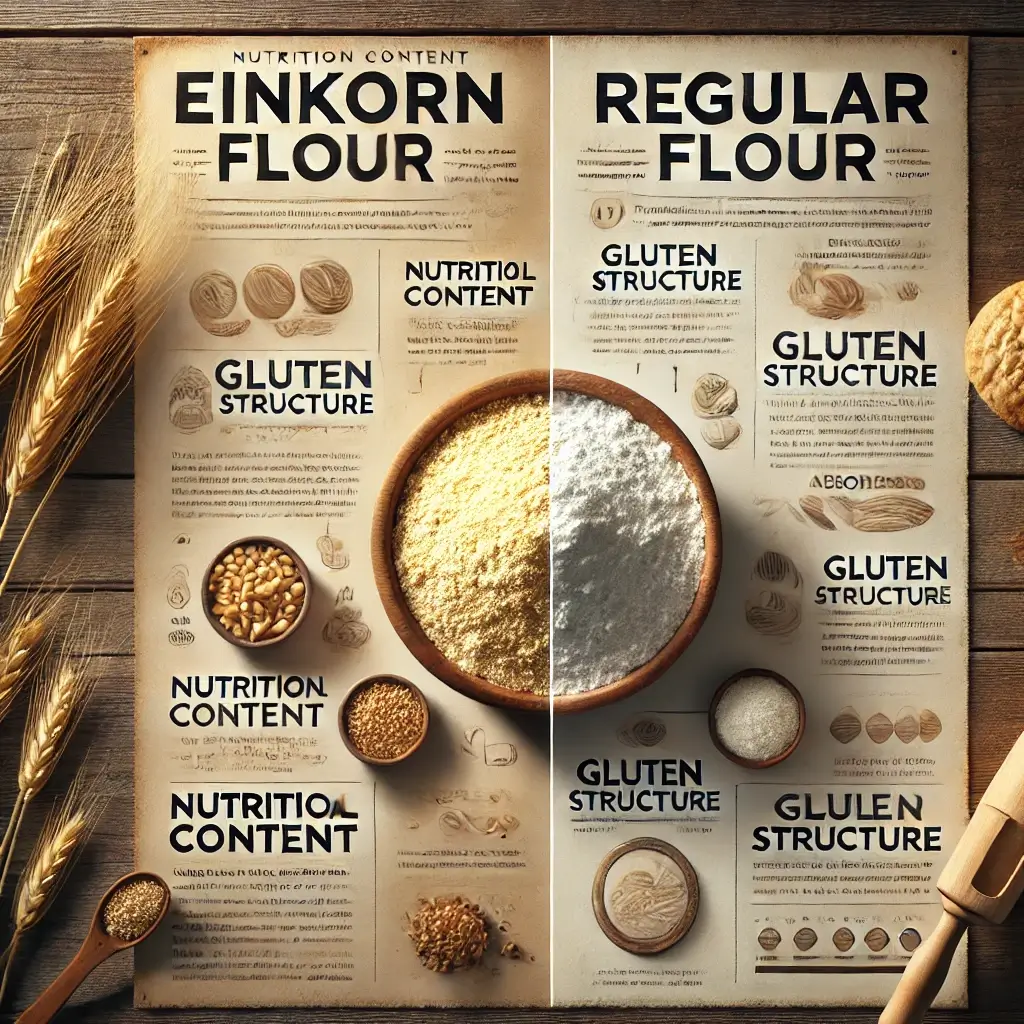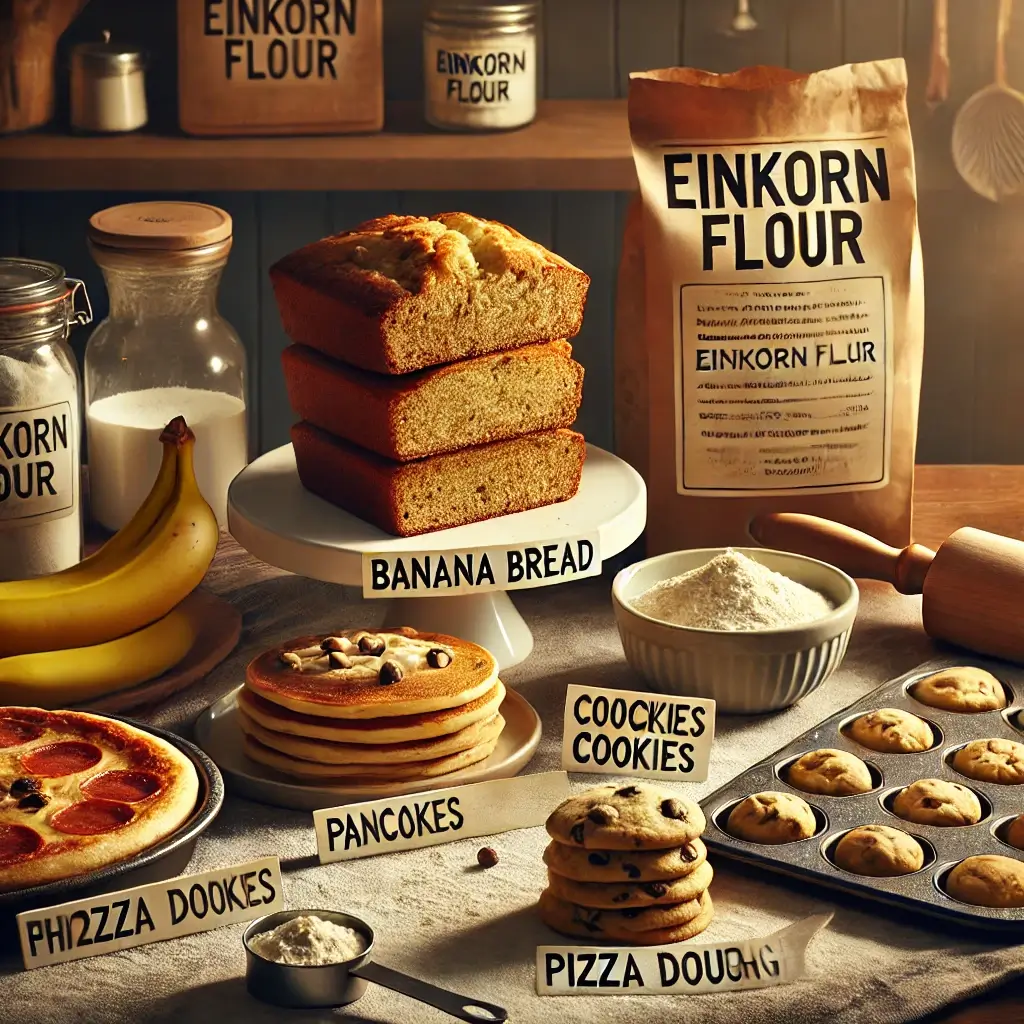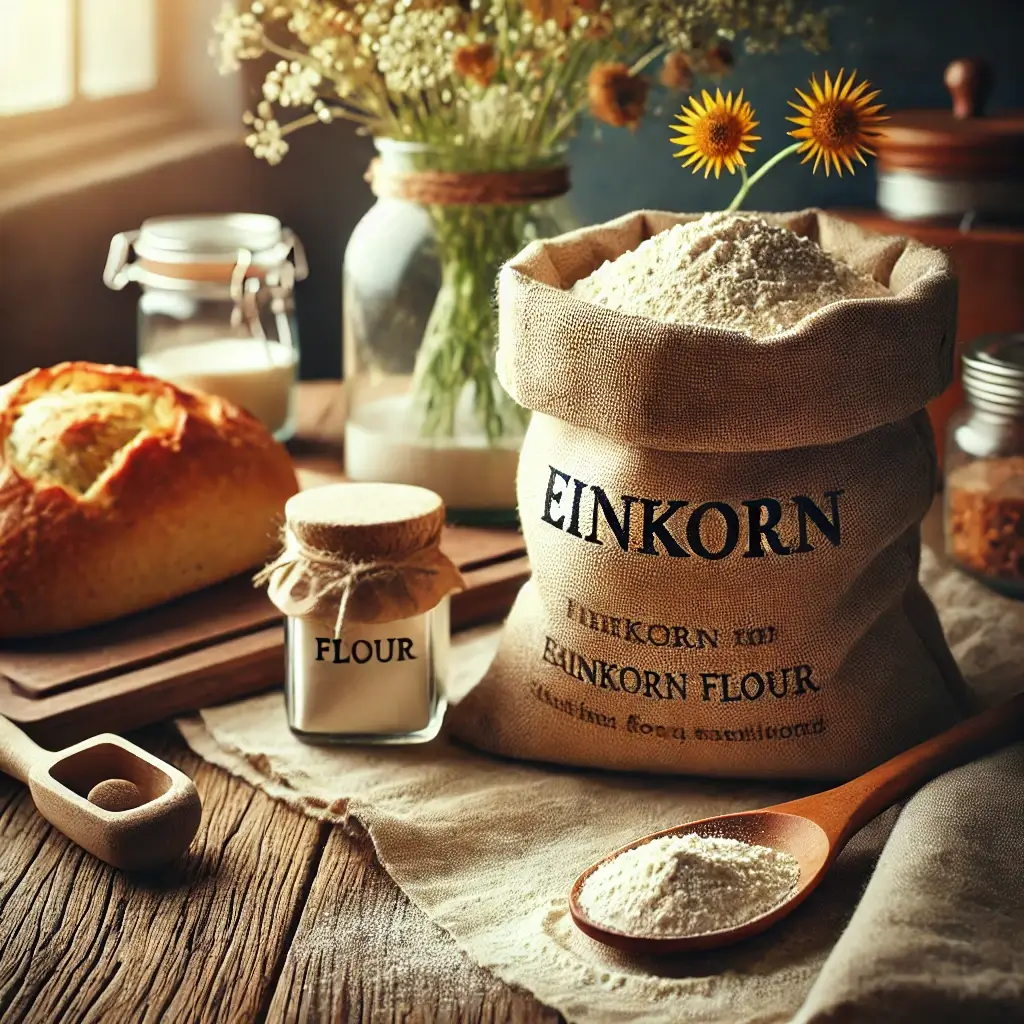Einkorn flour, one of the oldest forms of cultivated wheat, has made a major comeback in modern kitchens. Its nutritional benefits and unique nutty flavor make it a favorite among bakers and health enthusiasts alike. But substituting einkorn flour in recipes can be a bit tricky due to its distinct properties. Whether you’re new to einkorn or looking to perfect your recipes, this guide will help you navigate its substitution process with ease.
Why Choose Einkorn Flour?
Before diving into the substitution techniques, let’s understand why einkorn flour is worth considering:
- Nutritional Benefits: Einkorn is higher in protein, vitamins, and minerals like iron, zinc, and magnesium compared to modern wheat.
- Digestibility: Many people find einkorn easier to digest due to its lower gluten content and simpler genetic structure.
- Flavor Profile: Its subtle nutty and sweet taste enhances the flavor of baked goods, making it a great choice for pancakes, bread, muffins, and even pasta.
However, its unique characteristics can make substituting einkorn in recipes challenging. Let’s explore how to do it effectively.
Key Differences Between Einkorn Flour and Regular Flour
To successfully substitute einkorn flour, it’s essential to understand how it differs from modern wheat flours:
- Gluten Structure: Einkorn has a different gluten composition, which makes it less elastic. This affects dough handling and rising.
- Absorption: Einkorn absorbs liquids differently, often requiring less water or other liquids.
- Density: It’s naturally lighter, giving baked goods a softer texture when handled correctly.
- Protein Content: While it has high protein levels, its gluten protein is weaker, which impacts structure in baking.

How to Substitute Einkorn Flour in Recipes
1. Start Small
If you’re new to einkorn, begin by substituting it for only a portion of the flour in your recipe, such as 25%-50%. This allows you to adjust to its unique behavior without dramatically affecting the outcome of your dish.
- Example: In a recipe calling for 2 cups of all-purpose flour, use 1 cup of einkorn flour and 1 cup of all-purpose flour.
2. Adjust Liquid Quantities
Einkorn flour tends to absorb less liquid compared to modern wheat flours. This means you’ll often need to reduce the amount of liquid in your recipe.
- Tip: Start by cutting liquids by 10-15%. For example, if your recipe calls for 1 cup of water, use about ¾ cup instead.
If the dough feels too dry after mixing, you can gradually add more liquid.
3. Watch Mixing Times
Einkorn’s weak gluten structure means it can become overworked easily. Overmixing leads to dense or gummy baked goods.
- For bread: Knead less than you would with traditional wheat flour.
- For cakes and cookies: Mix just until the ingredients are combined—no more.
4. Experiment with Rising Times
When baking bread, einkorn dough requires a shorter rising time due to its fragile gluten network. It’s essential to monitor the dough carefully to prevent overproofing, which can result in a collapsed loaf.
- Pro Tip: Allow the dough to rise to about 1.5 times its original size instead of doubling.
5. Consider Recipe Types
Certain recipes are better suited for einkorn flour substitutions than others:
- Best Matches: Pancakes, muffins, cookies, quick breads, and pasta.
- Challenging Recipes: Yeast-based breads, as they require more structural integrity.
6. Pair with Other Flours
For recipes that demand a strong gluten structure, such as pizza dough or baguettes, you can combine einkorn flour with stronger flours like bread flour.
- Example Ratio: 70% bread flour and 30% einkorn flour.
7. Measure by Weight, Not Volume
Einkorn flour is lighter and less dense than all-purpose flour, which means a cup of einkorn doesn’t weigh the same as a cup of regular flour. Using a kitchen scale ensures accurate substitutions.
- Conversion: 1 cup of einkorn flour typically weighs about 96 grams.
8. Adapt Leavening Agents
When using einkorn in recipes with baking powder or baking soda, you may need to slightly reduce these agents to avoid over-rising and collapse.
- Reduce by about 10-15%.
Practical Substitution Examples
Here are a few examples of how to substitute einkorn flour in common recipes:
- Pancakes:
- Replace all-purpose flour with 100% einkorn flour.
- Reduce milk by about ¼ cup.
- Mix gently for fluffier results.
- Muffins:
- Substitute 50-75% of the flour with einkorn.
- Use slightly less baking powder and liquid.
- Bread:
- Use a blend of einkorn and bread flour.
- Shorten rising times and handle the dough gently.
- Cookies:
- Einkorn works well as a full replacement.
- Be cautious with mixing and monitor baking times closely.
Troubleshooting Common Issues
Despite your best efforts, you may encounter challenges when substituting einkorn flour. Here are solutions to some common problems:
- Dough Feels Sticky:
- Sprinkle a small amount of additional einkorn flour to achieve the right consistency.
- Baked Goods Collapse:
- Reduce the liquid content or leavening agents.
- Avoid overproofing (for bread) or overmixing (for cakes).
- Dense Texture:
- Ensure proper hydration and shorter mixing times.
Benefits of Experimenting with Einkorn Flour
Switching to einkorn flour may take some trial and error, but the results are well worth it. You’ll enjoy:
- Healthier, more digestible baked goods.
- A unique flavor profile that enhances your recipes.
- The satisfaction of using an ancient, sustainable grain.
Part 2: Advanced Techniques for Substituting Einkorn Flour in Recipes
In Part 1, we explored the basics of substituting einkorn flour and some tips for achieving the perfect texture and flavor in various recipes. Now, let’s dive deeper into advanced techniques, specific recipe examples, and more refined strategies to help you master einkorn flour in your kitchen.
Advanced Tips for Einkorn Flour Substitution
1. Adjusting for Baking Times
Due to einkorn’s unique absorption and gluten properties, baked goods may cook faster than expected. Keep a close eye on your oven to avoid overbaking or drying out your creations.
- General Rule: Reduce baking time by about 5-10% when substituting einkorn flour.
- For example, if a recipe suggests baking for 30 minutes, start checking at 25 minutes.
2. Using Einkorn in Sourdough Baking
Sourdough enthusiasts often love einkorn for its rich, earthy taste. However, working with einkorn in sourdough requires slight adjustments:
- Hydration: Lower the water ratio by 10-15% compared to regular sourdough recipes.
- Mixing: Perform gentle folds rather than vigorous kneading to avoid breaking the dough.
- Fermentation: Keep proofing times shorter. Einkorn sourdough tends to ferment faster due to its weaker gluten structure.
3. Thickening Sauces and Soups
Einkorn flour makes an excellent thickener for gravies, sauces, and soups. Its slightly nutty flavor adds a unique twist to savory dishes.
- Substitution: Use einkorn flour in a 1:1 ratio to replace all-purpose flour as a thickening agent.
- Tip: Whisk it into cold liquids before adding it to hot mixtures to avoid clumps.
4. Incorporating Einkorn into Pastry Dough
Einkorn works beautifully in pastries like pie crusts and shortbread. However, it requires a delicate touch:
- Use cold butter and minimal mixing to prevent overworking the dough.
- Refrigerate the dough before rolling to make it easier to handle.
- For flaky textures, incorporate a bit of all-purpose flour or pastry flour alongside einkorn.
Detailed Recipe Examples with Einkorn Flour
Let’s apply what we’ve learned to some classic recipes and see how to adapt them for einkorn flour.
1. Einkorn Pancakes
Einkorn pancakes are soft, fluffy, and full of flavor. Here’s how to make them:
Ingredients:
- 1 ½ cups einkorn flour
- 1 tablespoon sugar
- 1 teaspoon baking powder
- ½ teaspoon baking soda
- ¼ teaspoon salt
- 1 ¼ cups milk (reduce slightly if batter feels too thin)
- 1 large egg
- 2 tablespoons melted butter
- 1 teaspoon vanilla extract
Instructions:
- Mix the dry ingredients in a bowl.
- Whisk the wet ingredients in another bowl.
- Combine both, stirring gently until just mixed.
- Cook on a lightly greased griddle over medium heat.
Pro Tip: Don’t overmix; einkorn pancakes benefit from a lumpy batter for a fluffier texture.
2. Einkorn Banana Bread
Einkorn flour adds a delightful richness to banana bread.
Ingredients:
- 2 cups einkorn flour
- 1 teaspoon baking soda
- ¼ teaspoon salt
- ½ cup melted butter
- ¾ cup brown sugar
- 2 large eggs
- 3 ripe bananas, mashed
- 1 teaspoon vanilla extract
Instructions:
- Preheat oven to 350°F (175°C). Grease a loaf pan.
- Mix the dry ingredients in a large bowl.
- In another bowl, combine butter, sugar, eggs, mashed bananas, and vanilla.
- Slowly fold the dry ingredients into the wet mixture.
- Pour the batter into the loaf pan and bake for 50-60 minutes.
Adjustment Tip: If the batter looks too thick, add a splash of milk, but avoid over-hydrating.
3. Einkorn Pizza Dough
For a soft yet slightly chewy crust, einkorn pizza dough is a game-changer.
Ingredients:
- 3 cups einkorn flour
- 1 teaspoon salt
- 1 teaspoon sugar
- 1 packet (2 ¼ teaspoons) active dry yeast
- ¾ cup warm water
- 2 tablespoons olive oil
Instructions:
- Dissolve yeast and sugar in warm water; let it sit until frothy.
- Combine einkorn flour and salt in a large bowl.
- Add the yeast mixture and olive oil, mixing until a sticky dough forms.
- Knead gently for 2-3 minutes, then let the dough rise for about 45 minutes.
- Roll out, top with your favorite ingredients, and bake at 475°F (245°C) for 12-15 minutes.
Note: Reduce water slightly if the dough feels too wet.
4. Einkorn Chocolate Chip Cookies
These cookies have a tender crumb with a delightful chew.
Ingredients:
- 2 cups einkorn flour
- ½ teaspoon baking soda
- ½ teaspoon salt
- ¾ cup unsalted butter, softened
- 1 cup brown sugar
- ½ cup white sugar
- 1 large egg + 1 egg yolk
- 1 teaspoon vanilla extract
- 1 cup chocolate chips
Instructions:
- Preheat oven to 375°F (190°C). Line a baking sheet with parchment paper.
- Cream the butter and sugars until fluffy.
- Add eggs and vanilla, mixing well.
- Slowly add dry ingredients, mixing until just combined.
- Fold in chocolate chips.
- Scoop onto the baking sheet and bake for 10-12 minutes.
Tip: Chill the dough for 30 minutes to prevent spreading.

Common Mistakes to Avoid with Einkorn Flour
- Overhydration:
- Einkorn doesn’t absorb liquid like modern wheat. Always add liquids gradually to avoid a sticky mess.
- Overmixing:
- Its fragile gluten structure breaks down quickly. Gentle mixing is key to success.
- Expecting Similar Results to Modern Wheat:
- Einkorn has its quirks, and your baked goods may be softer or less structured. Embrace the difference!
Storing Einkorn Flour and Dough
Einkorn flour is best stored in an airtight container in a cool, dark place. If you bake with einkorn frequently:
- Refrigeration: Store fresh dough in the fridge for up to 3 days.
- Freezing: Freeze unused dough for up to 3 months for quick use later.
Summary of Advanced Techniques
- Lower liquid quantities and reduce leavening agents.
- Measure by weight for precision.
- Adapt rising times for breads and baking times for pastries.
- Pair einkorn with stronger flours for recipes that require extra structure.
Switching to einkorn flour doesn’t just mean healthier recipes—it means experiencing a whole new dimension of flavor and texture in your cooking.

